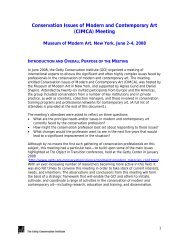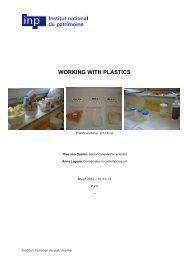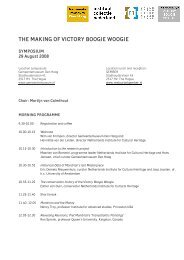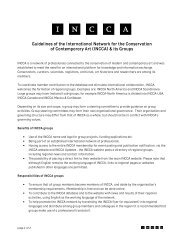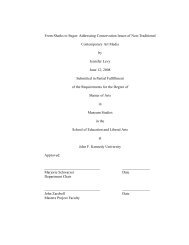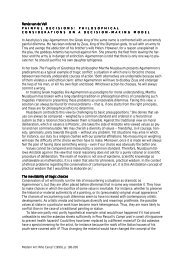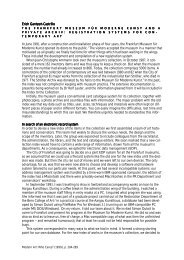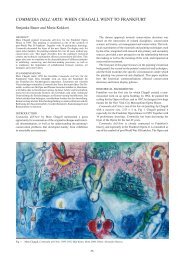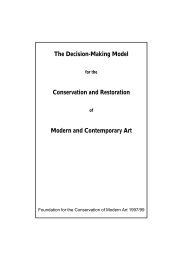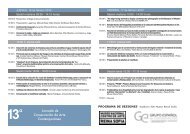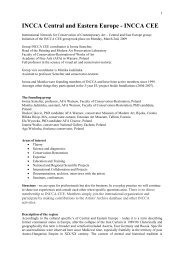VAN WEGEN, D.H. Between Fetish and Score - incca
VAN WEGEN, D.H. Between Fetish and Score - incca
VAN WEGEN, D.H. Between Fetish and Score - incca
- TAGS
- fetish
- score
- incca
- www.incca.org
Create successful ePaper yourself
Turn your PDF publications into a flip-book with our unique Google optimized e-Paper software.
D.H. D.H. van van van Wegen<br />
Wegen<br />
B B E E T T W W E E E E N N F F E E T T I SS S H H A N D S C C O O R R EE:<br />
E : T T H H E E P P O O S S I I T I O N N O F F F T T H H E<br />
E<br />
C C U U R R A A T O O R R O O F F C C O O N N<br />
T T E E M M P P O O R R A A R R Y Y A A R R TT*<br />
T<br />
On Kunstwollen <strong>and</strong> expressiveness<br />
The curator of contemporary art is confronted with the task of enabling the public to share in the<br />
experience of looking at art works that have not yet been freighted with historical interpretation,<br />
while ensuring that future generations will also be able to partake of these works. This article<br />
attempts to provide an overview of the theoretical <strong>and</strong> moral aspects of the complex problems of<br />
preserving contemporary art from the viewpoint of the art historian’s practice in the museum, <strong>and</strong><br />
to identify the approaches towards these problems that those responsible for preservation are often<br />
tempted to take. An alternative to these approaches is then deliberated, one that aims to do justice<br />
to the individual nature of non-traditional, contemporary art objects <strong>and</strong> the conditions required for<br />
optimum experiencing of the work, as well as the codes of ethics that have been developed for conservation<br />
<strong>and</strong> restoration.<br />
As background to this deliberation, first the dilemma between conservation <strong>and</strong> presentation is<br />
outlined followed by the development of conservation theory <strong>and</strong> ethics. Here, the term contemporary<br />
art does not apply to the painting in a frame or the sculpture on a plinth, works that are still<br />
being created today, but to all alternative forms of modern-day art. Where traditional art is mentioned<br />
it does not imply any value judgement, but only indicates a work made in a traditional form.<br />
The The museum’s museum’s dilemma<br />
dilemma<br />
The museum is a mass of contradictions. As an institute it originated from opening up to the public<br />
collections of artefacts <strong>and</strong> curiosities belonging to royalty <strong>and</strong> the aristocracy or to societies of<br />
cultured citizens. It is this public access to their collections, which are often as not public property<br />
today, that is a distinguishing feature of a museum. At the same time museums are obligated to<br />
h<strong>and</strong> down their collections to future generations. By becoming part of a museum collection, art<br />
works are, as it were, preserved in the collective memory of humankind, or at least in that of a specific<br />
group.<br />
The two most important duties of a museum, the preservation of a legacy for future generations<br />
<strong>and</strong> the displaying of artefacts to the general public, validate each other, yet they are also in conflict<br />
with each other. From a preservation viewpoint, the collection would be better stored in the dark or<br />
at least out of the public’s reach. In practice, however, within certain acceptably considered boundaries,<br />
museum objects are indeed exposed to effects <strong>and</strong> dangers that irrevocably shorten or<br />
directly threaten their survival. Thus the museum is continually faced with the task of seeking compromises<br />
between its two main functions.<br />
The The The devel develop devel develop<br />
opment op ment of of conser con<br />
ser serva<br />
vation va tion the theory the ory <strong>and</strong> eth ethics eth<br />
ics<br />
One of the results of this search for compromises is known as conservation. The term embraces all<br />
those measures that serve to promote the continued survival of an art work. Those measures that<br />
directly intervene in the preserved artefacts themselves are termed active conservation. These interventions<br />
generally take place after change or damage has been found. Such changes may trigger<br />
interventions because the work’s preservation is threatened or for other, possibly aesthetic reasons.<br />
When a work becomes unstable or threatens to disintegrate, preservation clearly becomes an<br />
issue. Aesthetic reasons, however, are much more subjective. This can be of concern if the art work<br />
becomes less presentable due to surface grime or slight discoloration. A third reason to intervene<br />
with the state of an object, <strong>and</strong> again tied in with its appearance, is the desired legibility of a crucial<br />
element of the work. For instance, a neon work with lights that no longer function does not tell us<br />
the original story.<br />
The objective of conservation work is generally ’to restore’. However, it has transpired that restoration,<br />
in the sense of returning a work to an earlier condition, is pure fiction. Generations of art<br />
restoration has shown that every intervention adds its own interpretation to the work in question.<br />
Modern Art: Who Cares? (1999), p. 201-209.
As well as being an interpretation of the work, every addition is also determined by the technical<br />
possibilities <strong>and</strong> the general visual ‘vocabulary’ available at the time of the intervention. For<br />
instance, the emergence of trateggio retouching would be inconceivable had Pointillism not existed<br />
as a means of expression in the same period. 1 Earlier restoration work can nowadays be dated with<br />
remarkable accuracy <strong>and</strong> sometimes even as-cribed to a specific restorer by experts in restoration<br />
history. A large part of the work of conservators who h<strong>and</strong>le art works of a certain age thus also<br />
involves un-doing earlier restoration work <strong>and</strong> thereby the interpretations of their predecessors.<br />
In opposition to these continuously changing interpretations – every age looks at the products<br />
of previous ages, no matter which, through its own spectacles – the search by art historians for an<br />
objective or ‘historically accurate’ interpretation is constant. In the 1930s the German art historian<br />
<strong>and</strong> theorist, Alois Riegl, defined the idea Kunstwollen as the “complex of conditions that produces<br />
the art work’s particular design”. 2 Thus Kunstwollen embraces both the artistic intention of the artist<br />
as well as all the social factors that have determined the actual genesis of the art work. One can<br />
therefore interpret Riegl’s Kunstwollen as that which one would find if an objective <strong>and</strong> historically<br />
accurate interpretation were possible. Although we still inhabit the same context as the one from<br />
which contemporary art springs, paradoxically, <strong>and</strong> as a consequence of the individual nature of<br />
artistic concepts in contemporary art, an objective interpretation, or even one based on consensus,<br />
is even less accessible than with the more traditional art forms of the past.<br />
In this sense, art restoration is always ‘anachronistic’ because it is always determined under the<br />
influence of an interpretation of a certain moment. In his Teoria del Restauro (Rome, 1963), the art<br />
historian Cesare Br<strong>and</strong>i formulated the principle that the original material identity of an object<br />
should always remain the most important source for ever-changing interpretations. To this he adds<br />
the conclusion that the original material should as far as possible be preserved. The practical application<br />
of this theory can be found in numerous codes of ethics for day-to-day conservation practice,<br />
in which restraint <strong>and</strong> reversibility of treatment are formulated as the most important principles.<br />
These codes of ethics have been drawn up with a view to keeping anachronistic additions to a minimum<br />
<strong>and</strong> to keep them reversible. In order to remain a departure point in the future for everchanging<br />
interpretations, the original material should always remain recognisable despite any later<br />
additions.<br />
A later phase in the development of restoration theory describes how an intervention in an art<br />
work will not only always bear traces of the interpretation of a certain historical moment, but also<br />
how, at that moment, a choice is always made – explicit or otherwise – for particular aspects of the<br />
work. Thus, with conservation problems involving an intervention, there is not usually a single, universal<br />
solution. A choice always has to be made between various options, each of which only<br />
favours certain aspects of the art work. For instance, maintaining the original material may be done<br />
at the expense of its original appearance. A specific site - for which a work was originally made –<br />
<strong>and</strong> this applies just as much to a late twentieth-century installation as a sixteenth-century altar<br />
piece – can have an intellectual or numinous impact which is lost whenever a work is transferred to<br />
another location, or the site itself drastically changes, whether for conservation or other museological<br />
reasons.<br />
In 1987, a descriptive model for decision-making processes relating to conservation issues was<br />
presented to the Theory <strong>and</strong> History of Restoration working group of the ICOM (International<br />
Council of Museums) Committee for Conservation. This was a circle from the orbit of which vectors<br />
point inwards representing various considerations such as authenticity, historicity, aesthetic<br />
aspects, functional aspects as well as legal <strong>and</strong> economic preconditions. 3 This model illustrates<br />
how decision making in a conservation process is determined by the importance as- cribed to the<br />
various considerations. At the same time the model makes it graphically clear that the outcome of<br />
such a process is always a compromise in which there are no gains without losses.<br />
This model breaks with the idea that various options <strong>and</strong> considerations are quantifiable <strong>and</strong><br />
can be set off against a system of non-variable norms, which indicate a priori what the result<br />
should be. The model emphatically introduces the elements subjectivity, conflict <strong>and</strong> loss. In every<br />
instance, the most desirable solution for a conservation problem will have to be sought <strong>and</strong> found<br />
by weighing the positive <strong>and</strong> negative implications against each other.<br />
Modern Art: Who Cares? (1999), p. 201-209.
In practice, along with explicit aesthetic <strong>and</strong> historical considerations, implicit factors also play a<br />
part in conservation issues. For example, the fact that completeness <strong>and</strong> a certain airiness are generally<br />
valued in a positive sense in our culture is often taken into account without us always being<br />
conscious of it. Besides describing a decision-making process, the ICOM-CC is also intended to<br />
reveal these hidden yet telling factors, to clarify the multidisciplinary nature of the question posed,<br />
<strong>and</strong> to give the loss of any value its own place. The ultimate intention is that the model will enable<br />
the decision-making process in conservation projects to be more thoroughly considered.<br />
A A tragic tragic conflict con<br />
con flict<br />
From the contribution of the philosopher Renée van de Vall to the theoretical working group of the<br />
Conservation of Modern Art project, it appeared that the development in conservation theory outlined<br />
above has its parallels in more general theories on problem-solving. For the other members<br />
of the group, chiefly conservators <strong>and</strong> art historians, there was a highly agreeable sense of identification<br />
on learning that recent theoretical models <strong>and</strong> methods developed in philosophy also<br />
create a place for the loss incurred when one is forced to make a choice between two ‘evils’. There<br />
will always be a regrettable loss, no matter which solution is chosen. The philosopher Martha<br />
Nussbaum describes these situations as ‘tragic conflicts’. Van de Vall revealed the members of the<br />
working group to be genuine neo-Aristotelians. After all, Aristotle viewed values as plural <strong>and</strong> noncommensurable<br />
<strong>and</strong> stated that once a choice is made, an obviously right choice, one would always<br />
feel the pain because something is definitely lost forever. 4<br />
The The The con conser con conser<br />
serva serva<br />
vation va tion of of non-traditional objects<br />
The conservation issues associated with contemporary non-traditional art objects are not only distinguished<br />
by subjectivity, conflict <strong>and</strong> loss as described in the aforementioned model, but also have far<br />
more complex <strong>and</strong> indiscernible problems than traditional painting <strong>and</strong> plinth sculpture. There are broadly<br />
three reasons for this:<br />
1 The extreme fragility <strong>and</strong> unpredictable ageing of the often highly unorthodox materials used.<br />
2 The different role of materials <strong>and</strong> the creation process in the meaning of the work compared<br />
with traditional art.<br />
3 The lack of historical distance resulting in an interpretation of the work based on a feasible consensus<br />
is not yet possible.<br />
The problems of preservation linked to the type of materials used, which are often both extremely<br />
unstable <strong>and</strong> new so that the ageing process is often unpredictable, spring first to mind. This<br />
applies just as much to ‘just’ technical problems, requiring technical solutions <strong>and</strong> to which the<br />
applied sciences make an important contribution. Much more fundamental, however, is the difference<br />
in the role that the creative process <strong>and</strong> the material have on the meaning of the work. With<br />
traditional art the meaning of an object in a material sense is less ambiguous. Material <strong>and</strong> technique<br />
are to a great extent subservient to the meaning of the work, which is chiefly expressed in the<br />
form of a representation. 5 The materials of contemporary, non-traditional objects are in that sense<br />
not usually subordinate to the meaning contained in a representation. Since the early part of the<br />
twentieth century, art has become increasingly conceptual. The material identity of an art work is<br />
sometimes declared as being entirely of secondary importance. The extreme consequence of Conceptual<br />
Art is that the object is replaceable <strong>and</strong> that the work, for instance a Wall Drawing by Sol<br />
LeWitt, can be remade. Conversely, it also happens that materials <strong>and</strong> techniques convey all manner<br />
of meanings so that the object acquires a fetish-type significance. For instance, the large<br />
installation Eigentum Himmelreich (Heaven’s Property) by the German artist IMI Knoebel – consisting<br />
of paintings, drawings <strong>and</strong> sculptures – contains a part entitled Grosse Palette (Large Palette).<br />
In reference to the late Rainer Giese, whom Knoebel saw as a kindred spirit, he incorporated<br />
two ladders from the artist’s studio.<br />
Finally the expressive power of a work can be directly influenced by the fragility or evanescence of<br />
the material. This was the case with a challenging statement in ice called Melting Pot (Los Angeles<br />
Modern Art: Who Cares? (1999), p. 201-209.
1998) by Michel Delacroix, which was made to melt during a three-day conference on the preservation<br />
of twentieth-century art.<br />
A major consequence of the changing role material <strong>and</strong> technique play in the meaning of a work<br />
is that, in the case of active conservation procedures which directly intervene with the material<br />
quality of the art work, as outlined above, there must be a constant check on what role the material<br />
or the affected part plays in the meaning of the work. After all, every intervention can in fact have<br />
vital consequences for the meaning. Only once these consequences have been catalogued, can the<br />
pros <strong>and</strong> cons of a proposed conservation procedure be adequately weighed against each other.<br />
In the first instance, it seems illogical that the lack of historical distance to art works should be a<br />
stumbling block to this. After all, we live in the same artistic <strong>and</strong> conceptual context as that in<br />
which the work was made. The Kunstwollen should therefore still be recognisable <strong>and</strong> the danger of<br />
additional interpretations <strong>and</strong> anachronisms incurred during conservation treatment kept to a<br />
minimum. Although this obviously applies to artefacts that originate from a powerful <strong>and</strong> alive tradition,<br />
a tradition that still acts as a collective artistic concept, it does not apply to contemporary<br />
pieces that largely originate from a highly individual artis-tic intent. When these works are similarly<br />
defined in terms of Kunstwollen, due in part to highly personal factors, tradition <strong>and</strong> movement do<br />
not have a deducible influence but fulfil the role of a context to which the work relates. Due to its<br />
unique origin, the interpretation – certainly in the beginning – cannot be anything other than an<br />
individual one. 6 Only when there is an interpretative history of an object is there the possibility of<br />
an interpretation based more upon consensus.<br />
To sum up it can be said that with regard to the active conservation of contemporary, nontraditional<br />
art objects, treatment directly intervenes in the material, which in itself often conveys<br />
meaning. Moreover, there is still no recognisable interpretation embedded in art history, <strong>and</strong> therefore<br />
none which can convey a degree of objectivity for such a work. Because there is no frame of reference<br />
to indicate the meaning of the work, the interpretative aspects of materials at stake during a<br />
conservation intervention cannot be defined. The gains <strong>and</strong> losses cannot be made explicit, so that<br />
a well-considered weighing up of these aspects, as intended by the model described above, cannot<br />
as yet be made.<br />
The The temp tempta temp tempta<br />
tation ta tion of of the the curator: cura<br />
tor: creat creating creat ing doctrines doc<br />
trines<br />
Due to the complexity <strong>and</strong> imperceptiveness of the problems associated with conservation interventions<br />
in non-traditional contemporary art objects, it is even more difficult for those responsible<br />
to have an overview of the positive <strong>and</strong> negative effects of certain kinds of treatments than it is with<br />
traditional art. Moreover, curators who work with contemporary art often do so through a close personal<br />
involvement with the artist as a person <strong>and</strong> with his or her work. Not infrequently this concerns<br />
a work that still has to prove its right to exist, or a work that a curator, in his or her professional<br />
capacity, has personally experienced <strong>and</strong> has participated in the battle to secure a place for it<br />
in the annals of art history. At the same time, the purchase of contemporary art for museum collections<br />
often takes place in close consultation with the artists themselves. This makes it even more<br />
difficult, or virtually impossible, to adopt the attitude of one of Renée van de Vall’s Aristotelians<br />
who realise the irrevocable loss incurred in making a choice, feel the pain <strong>and</strong> nonetheless accept<br />
responsibility for it.<br />
The anxiety of making possibly reprehensible mistakes increases the desire for a system of<br />
graded st<strong>and</strong>ards that can simply <strong>and</strong> without further reflection be applied, i.e. a system of doctrines.<br />
In terms of the model described earlier, this means that the various considerations pointing<br />
inwards towards the circle would then be prioritised to a certain extent. The result would be that<br />
considerations that steer decisions in a different direction would be automatically declared of secondary<br />
importance. Guidelines would then be applied according to priority, replacing careful deliberation.<br />
Whenever there is the question of a loss of a value, this will by definition be of secondary<br />
importance <strong>and</strong> will therefore not have to be experienced as ‘painful’.<br />
Con Conser Con Conser<br />
serva<br />
vation va tion codes codes of eth ethics eth<br />
ics as as doctrines doc<br />
trines trines<br />
Modern Art: Who Cares? (1999), p. 201-209.
One way of grading the various considerations would be to consider existing conservation codes<br />
of ethics as a fixed st<strong>and</strong>ard system that can be mechanically applied. Current codes of ethics<br />
underline Br<strong>and</strong>i’s viewpoint that, in order to preserve an art work, the existing material object<br />
should be saved as far as possible, that conservation interventions in the art work should be kept to<br />
a minimum <strong>and</strong> then only to maintain the work as a material object – as a conveyor of information<br />
<strong>and</strong> as a source for continually changing interpretations. However, limiting intervention to what is<br />
needed for material survival will in practice often mean considerable changes to a work’s external<br />
appearance.<br />
Where Br<strong>and</strong>i’s guidelines are applied without further consideration to non-traditional, contemporary<br />
art objects, the question may be asked whether justice is done to the specific nature of these<br />
kinds of art works. Much more than with traditional painting <strong>and</strong> plinth sculpture, whereby a representation<br />
is ‘read’ according to certain codes, contemporary art is about having a direct experience<br />
of the work. A museum visitor ‘experiences’ rather than ‘regards’ these kinds of works. With<br />
Knoebel’s ladders in his Eigentum Himmelreich, or with objects from a performance that symbolically<br />
represent the original artistic act, ideas <strong>and</strong> meanings cling to the material itself so that the<br />
material object acquires significance as a fetish. But where this is not the case, it is chiefly the external<br />
appearance of a work that determines the expressive force of the artistic statement. Thus, where<br />
only the maintenance of an art work as a material object is considered, this will be at a substantial<br />
cost to the expressive force of much contemporary art. In extreme cases nothing more will remain<br />
of the art work other than ‘archaeological’ documentation, which simply provides information<br />
about its earlier existence as an art work.<br />
From this it follows that when conservation ethics intended for traditional art are indiscriminately<br />
applied to non-traditional, contemporary art objects they can considerably overreach their<br />
objective, which is, to h<strong>and</strong> down a work to future generations so that they in turn can experience<br />
<strong>and</strong> interpret it on their own terms. So while we indeed preserve the material object as an embodiment<br />
of Kunstwollen – <strong>and</strong> in certain cases the object has meaning as a fetish – we are meanwhile<br />
oblivious to the fact that the Kunstwollen can often no longer be ‘read’. In this case, we actually<br />
ignore the fact that as well as a material authenticity, there is a conceptual authenticity which is<br />
chiefly determined by the work’s external appearance. For the work to be continually experienced<br />
<strong>and</strong> interpreted anew this also has to be preserved. If in preserving the material object the original<br />
appearance is lost, then a future museum-going public – in a different way to interpretative interventions<br />
– is nevertheless still prevented from experiencing <strong>and</strong> interpreting the work in its own<br />
particular way. We can ask ourselves whether Manzoni’s soiled Achromes or the originally shiny,<br />
polished bronzes of Brancusi, which have now acquired the patina of time, are still the same works<br />
they were when originally made.<br />
From a careful reading of the codes of ethics, it is also apparent that these codes expressly leave<br />
room for a more casuistic approach. The code of practice for the Dutch Art Conservators Association,<br />
in relation to the substitution of materials, states that “as much care as possible” should be<br />
exercised <strong>and</strong> that this should take place “only after careful research, <strong>and</strong> obviously in consultation<br />
with the client”. Thus, conservation codes of ethics also specifically allow replacement of material<br />
after the case has received due deliberation. 7<br />
The The artist’s artist’s author authorised author ised solution solu<br />
tion<br />
Another frequently recurring way of creating a hierarchical scale for the various considerations is to<br />
declare that the artist’s opinion is of a higher order than any other consideration. From his or her<br />
personal involvement the curator reconciles the identity of the piece – often defined as the integrity<br />
of the object – with the artist’s views. A proper h<strong>and</strong>ling of the work is then equated with following<br />
the artist’s opinion uncritically.<br />
Obviously, artists are a vital source of all kinds of information on the origins <strong>and</strong> meaning of<br />
their works. Their views on the desirability <strong>and</strong> consequences of a conservation measure should<br />
therefore be assessed <strong>and</strong> taken into account when decisions are being made. However, the work<br />
<strong>and</strong> the maker are not interchangeable. The interpretation of contemporary art is the task of the art<br />
historian. When interpreting much twentieth-century art the iconography of the material used will<br />
Modern Art: Who Cares? (1999), p. 201-209.
itself ultimately prove to be a decisive factor. Elevating the artist as an authority on various questions<br />
of preservation is putting the problem <strong>and</strong> responsibility for a solution where it does not<br />
belong. When a curator, due for instance to insufficient historical distance, is unable to interpret an<br />
art work properly in order to assess the effects of conservation treatments, this responsibility cannot<br />
be simply shifted to the artist. The fact that artists are not the best spokespersons on the meaning<br />
of their work is already apparent from their decision to express themselves in an art work in the<br />
first place.<br />
Just how pressing the need for an authorised solution from the artist is, becomes evident when<br />
we see how far people are prepared to go to stretch the artistic concept of the maker. If the artist is<br />
no longer available, a statement about a work – whether made shortly after its inception or later –<br />
is often used to solve an unforeseen problem. If an artist has never spoken specifically about the<br />
work in question, statements about other works are sought which are then used analogously. If<br />
none of these exist, then the artist’s ‘poetics’ can still be extracted from his or her views on art <strong>and</strong><br />
life in general, followed by an extensive critical interpretation in order to reach a solution for a problem<br />
that was unforeseen in this form. After an artist’s death, his or her identity is not infrequently<br />
extended to the wife, husb<strong>and</strong> or partner, or even a studio assistant. Although these people are<br />
often experts on certain aspects of the origin of the work (the partner in an emotional sense; the<br />
assistant technically or intuitively), it does not imply in any way that they identify with the artist, <strong>and</strong><br />
even less so that they are interchangeable with the artist as he or she was at the particular moment<br />
in the past when the work was made. They are therefore not necessarily the best qualified to interpret<br />
the specific expressiveness of the work <strong>and</strong> the materials used. Thus, to declare such people as<br />
authorities when solving conservation problems is again misplacing the responsibility. A possible<br />
effect of this was revealed with the treatment of Barnett Newman’s Who’s Afraid of Red, Yellow <strong>and</strong><br />
Blue III in the collection of the Stedelijk Museum, Amsterdam.<br />
From the reaction of artists who, as part of the Conservation of Modern Art project, were asked<br />
for suggestions on how to solve conservation problems, it became apparent that they too make a<br />
clear distinction between creating a work <strong>and</strong> the measures required for securing its continued existence.<br />
The sculptor Tony Cragg was extremely unambiguous about this. In an interview with Lydia<br />
Beerkens <strong>and</strong> Christiane Berndes elsewhere in this volume, he said that he does not want to involve<br />
himself specifically with conservation matters because it is not his job: “The artist makes the art<br />
work <strong>and</strong> does that but once. You can’t make the same work again twenty years later.” 8 When the<br />
working group confronted Dutch artist Krijn Giezen with his disintegrating Marocco, he mainly saw<br />
this as a new artistic challenge. From this a new art work could emerge that would substitute the<br />
old one.<br />
Is it then the case that artists may not change or add anything to a work once it leaves the studio?<br />
In my opinion the rationale of allowing artists to solve conservation problems is related to a<br />
graded time scale. The artist <strong>and</strong> the work come together through the artistic intentions in the<br />
Kunstwollen at the moment that the work comes into being. Afterwards these works take their<br />
place in art history <strong>and</strong> the artists go on to follow their own personal development. When problems<br />
arise soon after the purchase of a new work, which is not uncommon, <strong>and</strong> the artist is immediately<br />
asked for a solution, one can assume that the artistic concept <strong>and</strong> the personality of its maker have<br />
still not separated so that the moment of creation can be somewhat extended, as it were. But the<br />
greater the distance from that moment, the further away are the artists from the artistic concept. It<br />
is therefore impossible for them to still be regarded as part of the Kunstwollen of the work.<br />
The solving of problems that were unforeseen when the work was created can also not be<br />
regarded as having already been part of the identity of the work as an historic phenomenon. The<br />
essential nature of the work with all its possible interpretations was, as far as the artist is concerned,<br />
determined at the moment the work was completed. On the other h<strong>and</strong>, during its lifetime,<br />
the work – independent of the artist – can acquire new meanings that were not originally included<br />
in the Kunstwollen. Interpreting the meaning of art works, including the implication of a conservation<br />
procedure to the relevant parts, belongs, as has already been stated, to the domain of the art<br />
historian. However, the curator/art historian working with contemporary art is, as such, incapable<br />
of suspending the assumptions of the age. It is therefore impossible to reach an objective interpre-<br />
Modern Art: Who Cares? (1999), p. 201-209.
tation of the relevant material aspects <strong>and</strong> to carefully weigh up the consequences of any intervention.<br />
It is precisely for this reason that curators – as the people responsible for conservation –<br />
should not frustrate the work of their future colleagues.<br />
The The dilemma dilemma of of the the cura curator cura curator<br />
tor of of contem con<br />
contem<br />
tempo<br />
porary po rary art<br />
The curator as the person responsible for the continued existence of contemporary art is therefore<br />
in an extremely awkward predicament. Not only do curators always have to accept the sense of loss<br />
when art works for which they feel a strong <strong>and</strong> personal attachment receive conservation treatment,<br />
but, due to a lack of historical distance, little can as yet be said about the nature <strong>and</strong> impact<br />
of this loss. What the curator would actually like is to preserve the material identity of the art work<br />
without this necessarily being at the expense of the appearance <strong>and</strong> thereby the artistic statement.<br />
Those responsible for preservation who create a hierarchical scale by either declaring the material<br />
identity of the art work inviolate <strong>and</strong> in so doing make the sensory perceivable appearance of<br />
secondary importance, or by elevating the artist or a representative (studio assistant or life partner)<br />
to an authority on conservation matters, are closing their eyes to this loss. If they do not do this,<br />
they face the tragic conflict described by Martha Nussbaum. Curators then find themselves in a situation<br />
in which they are forced to choose between two morally undesirable courses of action.<br />
In practice the choice broadly comes down to maintaining the art work as a statement in which<br />
the expressive power of the work is the criterion <strong>and</strong> where everything is done to preserve the external<br />
appearance – even at the expense of the original material – or by being extremely careful to<br />
intervene in the object in order to retain the original material, because this is the only objective<br />
expression of its Kunstwollen. Both options are basically undesirable in that each of them violates a<br />
valid claim.<br />
Furthermore, in the first instance, only an experience can be reconstructed that recalls or suggests<br />
the original one. Viewers that experience the work will be no longer the same as those who<br />
saw the work when it was first shown. Moreover, in subsequent presentations of the work increasingly<br />
more subjective, interpretative elements will creep in unnoticed, at the expense of the physical<br />
art work as an objective source of its Kunstwollen.<br />
Conversely, when the expressive power of the external form is deemed subordinate to the material<br />
identity, is that which is ultimately preserved an objective document – since subjective additions<br />
are avoided. But, in many instances, as the source for an experience, it will only have value in<br />
as far as it functions as a fetish. In most cases an essential part of the conceptual authenticity <strong>and</strong><br />
thus the identity of the work will then be lost.<br />
In practice both approaches are found alongside each other. Depending on how much idealised<br />
freight one ascribes to the material used, or to the sensory perceivable appearance, the object is<br />
either treated as a fetish, or chosen in order to reconstruct the original appearance, even if this is<br />
done at the expense of the original material.<br />
Thea Theatre Thea tre as as truth, truth, mate material mate<br />
rial as ref refer ref<br />
er erence er ence<br />
It was mentioned earlier that much contemporary art is not ‘regarded’ so much as an experience<br />
undergone via sensory observation. In other words, the works are similar to visual, rather than literary<br />
theatre. What is represented may be static, but it often consists of movement – for example<br />
Tinguely’s kinetic objects or Bill Viola’s video art. With certain installations such as Hok 1 (Cabin 1)<br />
by Suchan Kinoshita, museum visitors themselves add an extra dynamic to the work by inverting<br />
different-sized hourglasses containing various coloured fluids, in an enclosed space.<br />
It is precisely this theatrical aspect that indicates in which direction a possible solution may be<br />
found for the dilemmas outlined above. Theatre as an art form communicates truth by means of<br />
illusion. In the theatre this does not happen in the form of an object, but through the visual experience<br />
of a presentation, the performance. Aside from pure improvisation, this external phenomenon<br />
is usually considered an original artistic product, quite separate from the written aspect of the<br />
piece. As a result interpretation has an explicit place.<br />
Modern Art: Who Cares? (1999), p. 201-209.
An essential difference between theatre <strong>and</strong> contemporary art is that, no matter how theatrical<br />
in its outward appearance <strong>and</strong> literary in its connotations the latter may be, there is no written work<br />
to use as a reference for its execution. The material object is the only actual reference. Br<strong>and</strong>i’s<br />
rationale that the original material identity of an art work must remain at all times the most important<br />
source for continuously changing interpretations therefore remains fully valid. Interventions to<br />
the material aspect of an art work in order to remain as close as possible to its original outward<br />
appearance whenever it is shown, <strong>and</strong> thus create the impression of an original experience, is ultimately<br />
placing interpretation on top of interpretation. To reproduce the original appearance it will<br />
be necessary, whenever this is done via interventions in the object, to fall back increasingly on documentation.<br />
This does not necessarily imply that there is no room for repeating the original appearance of a<br />
piece when presenting contemporary art. In order to preserve both the artistic statement <strong>and</strong> to<br />
convey to a future public something of the original experience of the piece, the original appearance<br />
should be repeated without damage to the material identity of the art work. This can be done by<br />
separating the art work as a visual phenomenon from its material quality. The original art work as a<br />
material object can then be consolidated without the presumed original appearance necessarily<br />
being the only guiding principle. At the same time, justice can be done to the theatrical nature of<br />
the visual experience of much contemporary art by creating exhibition copies in which the main<br />
concern is to communicate the artistic statement to the museum public. Then the interpretative<br />
aspect – a taboo, undesirable <strong>and</strong> thus often denied in relation to conservation procedures carried<br />
out on the object itself – can have its own explicit place. The original material piece can then be<br />
preserved as an objective source of its Kunstwollen <strong>and</strong> also act as a score for each new execution.<br />
The interpretation of the exhibition copy can also fulfil an interesting role as a commentary on<br />
the original work. The public <strong>and</strong> the art critics can then compare the way in which, for instance,<br />
the curator Maria de Corral reinstalls a work with the way the same piece is presented by curators<br />
like Harald Szeeman, Lynne Cooke or Rudi Fuchs – just as the conductor Bernard Haitink’s interpretation<br />
of Mahler’s Fourth Symphony can be compared with that of Christopher Hogwood.<br />
The fact that artists sometimes think in terms of a theatre model is borne out by ideas regarding<br />
reinstallation within Conceptual <strong>and</strong> Minimal Art as well as in Arte Povera. The fact that artists<br />
then, consciously or otherwise, also come up against the absence of a score is evident from their<br />
attempts to define the interpretative margins when their work is being reinstalled. In an unpublished<br />
interview with Marianne Brouwer, Sol LeWitt said that while his earlier Wall Drawings could<br />
in theory be done by anyone, in the same way anyone can paint a Mondrian, certain of them<br />
required specific skills. Concerning the re-executing of several early Wall Drawings in the Netherl<strong>and</strong>s,<br />
LeWitt maintained that while various people in that country could be found for the ink drawings,<br />
only two Americans could apply the early ones done in pencil. In reply to how the Wall Drawings<br />
should be managed after his death, LeWitt replied that the conservators assigned to the works<br />
should always be in touch with those who originally did them. 9<br />
Suchan Kinoshita also leaves little room for interpretation. With a view to replacing certain elements<br />
of her Hok 1, including the hourglasses which, because of the way they function in this<br />
installation have a limited life span, Kinoshita appoints ‘godmothers’ who take over the responsibility<br />
for re-executing the relevant parts. There will come a day, however, when Sol LeWitt’s studio<br />
assistant is no longer around <strong>and</strong> the godmothers to Kinochita’s work will themselves have to<br />
appoint godmothers. If the material object can be seen as quite separate from the art work as a visual<br />
phenomenon <strong>and</strong> as such be treated separately, as proposed in the above, then the creation of<br />
such a chain of ‘authorities’ can be ab<strong>and</strong>oned. For who could conceivably be a better interpreter of<br />
the role of the studio assistant or of the godmother than the art work itself?<br />
1 ‘Entretien avec Marcel Broodthaers – Unterhaltung zwischen Jean Michel Vlaeminckx und Marcel<br />
Broodthaers’, translated from the French by Antje Quast, in: Marcel Broodthaers: Interviews &<br />
Dialogue 1946-1976, Wilfried Dickhoff (ed.), Kiepenhuer & Witsch, 1990, pp. 23-27, quote on p. 23.<br />
2 Exhibition m.u.se.e.d’.a.r.t.cab.ine.t d.es. e.sta.mp.e.s./Département des Aigles (Poèmes<br />
industriels.<br />
Modern Art: Who Cares? (1999), p. 201-209.
Tirages Limités et Illimités sur plastique), Librairie St. Germain-des-Prés, Paris, 29 October - 19<br />
November 1968.<br />
3 ‘Marcel Broodthaers, La Salle Blanche – l’ensemble des Plaques et l’Entrée de l’Exposition’, in:<br />
Journal 22e Bienal Internacional de Sao Paulo, 1994, states that Broodthaers made thirty-five<br />
designs during this period which were developed as positives <strong>and</strong> negatives, made into plastic<br />
reliefs <strong>and</strong> painted in various colours. Most of the plates are about 85 cm high <strong>and</strong> 120 cm wide;<br />
four plates measure 85 cm x 60 cm <strong>and</strong> es<br />
Portes du Musée is 220 cm x 180 cm.<br />
4 Behind the Museum 1966-1976, Exhibition catalogue of the former gallery Wide White Space;<br />
Brussels, Bonn, Marseille, 1994-1996 (German/English publication), p. 51.<br />
5 Interview with Maria Broodthaers-Gilissen for the project Conservation of Modern Art, held on 12<br />
December 1996 in Brussels.<br />
6 Behind the Museum, see note 4, p. 327 states which works were exhibited in the exhibition<br />
‘Marcel Broodthaers’ at Le Bailli in Brussels between 25 September <strong>and</strong> 3 November 1974.<br />
7 See note 2.<br />
8 Catalogue Marcel Broodthaers, Vereniging voor Tentoontellingen van het Paleis voor Schone<br />
Kunsten, Brussels, 27 September - 3 November 1974 (Dutch version translated from the French by<br />
Marian Verstraeten).<br />
9 See note 5.<br />
10 Stefan Germer, ‘Das Jahrhundertding, Ansatze zu einer Theorie und Geschichte des Multiples’,<br />
in: Das Jahrhundert des Multiple – Von Duchamp bis zur Gegenwart, second edition, Zdenek Felix<br />
et al., Stuttgart, 1995, pp. 63-66.<br />
11 See also: Dorothea Zwirner, Marcel Broodthaers, in the series ‘Kunstwissenschaftliche<br />
Bibliothek’, Tape 3, Cologne, 1997, p. 93.<br />
12 See note 1, p. 26.<br />
13 See note 5. According to Maria Gilissen, the man who made the plaques for Broodthaers can tell<br />
us nothing more because he has since died.<br />
14 See note 8.<br />
15 Exhibition catalogue Marcel Broodthaers Cinéma, Fundació Antoni Tàpies, Barcelona 17 April-29<br />
June 1997, pp. 126-130.<br />
16 See note 8.<br />
D.H. van Wegen is curator at the Bonnefantenmuseum<br />
*The article has been published in: Hummelen, IJ., Sillé, D., Modern Art: Who Cares?, Amsterdam:<br />
Foundation for the Conservation of Modern Art/ Netherl<strong>and</strong>s Institute for Cultural Heritage, 1999,<br />
p. 201-209.<br />
Modern Art: Who Cares? (1999), p. 201-209.



